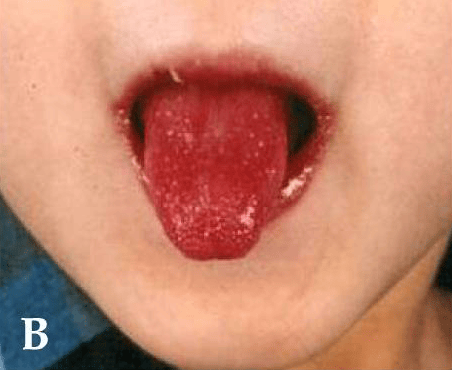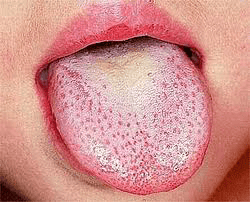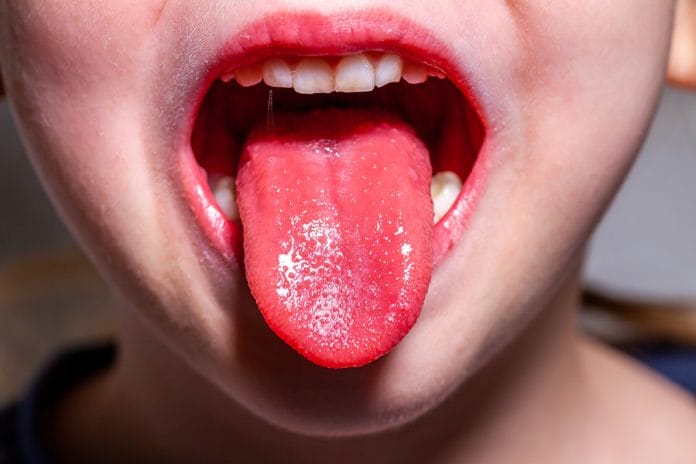Strawberry tongue, which is also called raspberry tongue, is described as a red tongue that is bumpy, swollen, and, in some cases, enlarged. The condition reflects a systemic issue rather than an oral disorder. When strawberry tongue is present, it means there is an underlying issue involved.
To determine the underlying cause, other symptoms will need to be considered.1 A healthy tongue is pink and covered in small papillae. These light pink papillae deepen and become red and inflamed in creating the appearance of a strawberry. White strawberry tongue has a white coating that the enlarged fungiform protrude through. Red strawberry tongue is where the white coating is lost, and the tongue is dark or bright red.
This condition is mostly seen in children and toddlers, although it can be present in adults as well. Treatment for strawberry tongue requires treating the underlying cause of the symptom.2
Kawasaki Disease & Strawberry Tongue
Kawasaki disease is an uncommon autoimmune illness that causes inflammation of small and medium-sized arteries, including the coronary arteries that supply blood to the heart muscle.
Oral signs such as strawberry tongue appear within the first few days after the fever starts and is considered one of the early signs of Kawasaki disease.3,4
Kawasaki disease occurs in three phases. The first phase (the acute phase during the first eleven days) includes the oral area with swelling, redness, prominent papillae, vertical cracking, and bleeding displayed on the tongue.3 Inflammation of mucous membranes of the mouth and throat results in dry, red, and cracked lips and an extremely swollen tongue (see Figure 1). During the second phase (the subacute phase, usually occurring between the 12th and 21st day), the symptoms turn to peeling of the skin on toes and fingers, joint and abdominal pain and swelling, jaundice, vomiting, and diarrhea. The third phase (the convalescent phase usually occurring between the 22nd day and end of the second month) is the recovery phase until all signs of the disease are gone.3,4
Other symptoms to determine Kawasaki disease as the underlying cause of strawberry tongue is high fever, or rashes − a morbilliform measles-like rash, a maculopapular rash displaying red patches and bumps or a target-like rash on the body.6
It is most common in children younger than five years of age, although it can occur at any age. Treatment is high dose aspirin therapy to decrease fever, pain, and joint inflammation. Immunoglobin therapy to reduce inflammation and lower the risk of long-term coronary problems.4

Scarlet Fever & Strawberry Tongue
Scarlet fever is a bacterial infection that occurs from group A strep when strep throat is left untreated or undertreated. When scarlet fever is active, the bacteria of step releases a substance that causes the strawberry tongue and the infamous rash. It is more common in children 5-15 years old.
To determine if the underlying cause of the strawberry tongue is scarlet fever, other symptoms may be a high fever and a red, bumpy, and sandpaper-like rash. Some of the oral symptoms are a flushed face with a pale ring around the mouth. The initial stage of scarlet fever develops a white strawberry (see Figure 2) tongue that turns red after four days.
These symptoms will usually last about seven days. Treatment for scarlet fever are antibiotics.5

Strawberry Tongue from Toxic Shock Syndrome
This is a life-threatening illness caused by toxins circulating in the bloodstream. The toxins are caused by Staphylococcus aureus. This is commonly caused by tampon use and nasal packing.
Toxic shock syndrome affects most organ systems in the body and produces a rash and high fever. To determine if the strawberry tongue is from toxic shock syndrome, other symptoms are a drop in blood pressure, vomiting, rashes, a sudden high fever, headache, diarrhea, an achy feeling all over, and redness in the eyes, lips, and the tongue.6
Treatment is with intravenous fluids, antibiotics, and medications to stabilize blood pressure.7
Strawberry Tongue from Vitamin Deficiency
Strawberry tongue can be caused by vitamin deficiencies such as low levels of vitamin B-12 and folate. A deficiency in these B vitamins disrupts the function of the nervous system, brain, and formation of red blood cells. If B-12 levels are low, it may result in anemia, a condition that lacks enough red blood cells in the body.
The tongue will appear as swollen and red, and taste buds will be enlarged.4 Other symptoms to determine if strawberry tongue is a vitamin deficiency are fatigue, weakness, memory difficulties, and balance problems.6 A higher risk of vitamin B deficiencies is genetics, autoimmune diseases, diabetes, Crohn’s disease, HIV, medications, vegetarian diet, age, and when parts of the stomach and intestines have been removed.8
Treatment is with supplements or dietary changes.6
Strawberry Tongue from Allergies
Strawberry tongue can be a symptom of allergies to foods or medications. An allergic reaction occurs when the immune system attacks what it considers a threat to the body and releases histamines. Common foods that cause this immune reaction are fruits and vegetables.1
Other symptoms to determine if strawberry tongue is from allergies are itchy, watery eyes, rash, scratchy mouth, and difficulty breathing.6 The treatment is to find the irritant, and, once the underlying symptom has been resolved, the tongue will return to its normal state.
Strawberry tongue can be correlated with a variety of systemic conditions. To determine the root cause of strawberry tongue is to be aware of the other symptoms involved. Once the underlying condition is resolved, the tongue will return to normal.
Before you leave, check out the Today’s RDH self-study CE courses. All courses are peer-reviewed and non-sponsored to focus solely on high-quality education. Click here now.
Listen to the Today’s RDH Dental Hygiene Podcast Below:
References
- Poole, J. (n.d.). Strawberry Tongue. MyMed. https://www.mymed.com/symptoms/strawberry-tongue
- Holland, K. (2018, August 31). What Causes Strawberry Tongue? Healthline. https://www.healthline.com/health/strawberry-tongue
- Mujahed, A., Lohr, K.M. (2019, September 25). Kawasaki Disease: Do you know the Signs? Medscape.
- Causes of Strawberry Tongue: Symptoms and Treatment Options. (2010, July 15). Tandurust. https://www.tandurust.com/oral-care/strawberry-tongue-causes-treatment.html
- Johnson, S. (2022, November 10). Scarlet Fever. Healthline. https://www.healthline.com/health/scarlet-fever
- Burgess, L. (2018, February 12). What You Should Know about Strawberry Tongue. Medical News Today. https://www.medicalnewstoday.com/articles/320894
- Bushra, J.S. (n.d.). Toxic Shock Syndrome. eMedicineHealth. https://www.emedicinehealth.com/toxic_shock_syndrome/article_em.htm
- Vitamin B-12 Deficiency Anemia. (n.d.). Cedars Sinai. https://www.cedars-sinai.org/health-library/diseases-and-conditions/v/anemia-of-b12-deficiency.html












